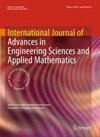香蒲中苯二醇和微晶纤维素对金胺O的吸附
IF 0.8
Q3 ENGINEERING, MULTIDISCIPLINARY
International Journal of Advances in Engineering Sciences and Applied Mathematics
Pub Date : 2023-03-01
DOI:10.11591/ijaas.v12.i1.pp27-36
引用次数: 1
摘要
苯二醇具有较大的表面积,介孔结构,含有硅烷醇(Si-OH)和铝醇(Al-OH)活性基团。除了和二醇,纤维素也是一种很好的吸附剂,因为微晶纤维素有一个活性羟基(OH)。活性吸附剂基团的数量可以通过化学修饰表面积(增量)或添加其他材料来增加。这些改性包括添加NaOH的碱性改性和二醇以增加孔径,用HCl水解纤维素以增加表面积,以及加入其他材料(主要是纤维素)的改性和二醇以增加表面积。吸附过程完成后,已知和二醇微晶纤维素(AMS)对金胺O (AO)的吸附能力。作为AO吸附剂,BET和二醇的表面积为25.92 m2/g,孔径为14.40 nm,而微晶纤维素和AMS吸附剂的表面积分别为26.60 m2/g和18.60 m2/g。AMS对AO的最大吸附条件为pH为7,接触时间为5 min时吸附效果最佳,吸附剂比为1:1时吸附浓度为40 mg/L时吸附效果最佳。吸附动力学和等温线更符合拟二阶和Langmuir等温线,吸附量为5.24 mg/g。本文章由计算机程序翻译,如有差异,请以英文原文为准。
Andisol and microcrystalline cellulose from Typha angustifolia for auramine O adsorption
Andisol has a large surface area, is mesoporous, and contains the active groups' silanol (Si-OH) and aluminol (Al-OH). Besides andisol, cellulose is a good adsorbent, because microcrystalline cellulose has an active hydroxyl group (OH). The number of active adsorbent groups can be enhanced by chemically modifying the surface area (increment), or adding other materials. These modifications included alkaline modified-andisol with the addition of NaOH to increase pore size, cellulose hydrolysis with HCl to increase surface area, and andisol modification with the inclusion of other materials, mainly cellulose, to increase surface area. After the adsorption process is complete, the adsorption capacity of andisol-microcrystalline cellulose (AMS) to auramine O (AO) is known. As an adsorbent for AO, the surface area of BET andisol is 25.92 m2/g and the pore diameter is 14.40 nm, while the surface area of microcrystalline cellulose and AMS adsorbent are 26.60 m2/g and 18.60 m2/g, respectively. The maximum AO adsorption conditions by AMS were at pH 7, optimum at a contact time of 5 minutes, and maximum at a concentration of 40 mg/L with an adsorbent ratio of 1:1. The adsorption kinetics and isotherm more closely followed the pseudo second-order and Langmuir isotherm with an adsorption capacity of 5.24 mg/g.
求助全文
通过发布文献求助,成功后即可免费获取论文全文。
去求助
来源期刊

International Journal of Advances in Engineering Sciences and Applied Mathematics
ENGINEERING, MULTIDISCIPLINARY-
自引率
0.00%
发文量
6
期刊介绍:
International Journal of Advances in Engineering Sciences and Applied Mathematics will be a thematic journal, where each issue will be dedicated to a specific area of engineering and applied mathematics. The journal will accept original articles and will also publish review article that summarize the state of the art and provide a perspective on areas of current research interest.Articles that contain purely theoretical results are discouraged.
 求助内容:
求助内容: 应助结果提醒方式:
应助结果提醒方式:


